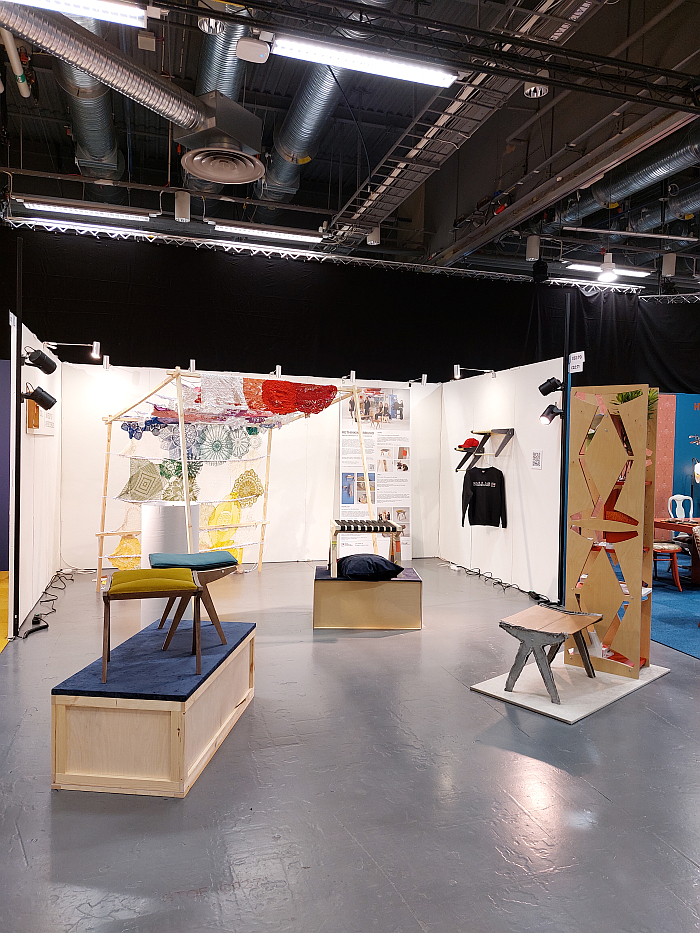
"Mis on disain?" What is design? asked once the Estonian designer Bruno Tomberg.1
What is Bruno Tomberg?, we, essentially, asked in context of the exhibition Bruno Tomberg. Inventing Design at the Estonian Museum of Applied Arts and Design, Tallinn.
What is Bruno Tomberg in 2025 and beyond? was, essentially, the question posed by and off students from the Textile and Furniture Departments of Pallas University of Applied Sciences, Tartu, in context of the project Mõtestades Brunot, Rethinking Bruno, which, as the title tends to imply, challenged the students to explore works by Tomberg and then, well, rethink them in context of today and contemporary realities. Rethinkings that were presented in the Greenhouse at Stockholm Furniture Fair 2025.
A presentation we initially misread as Rethinking Brno, and thus assumed to be an urban planning project based in the Moravian metropolis, quickly realised our error. And that to our immense delight.
A presentation of works that, one can argue, hopefully without falling into the trap of misrepresentation and distortion through looking too hard, but that risk is always present at such moments, that represented the wrestling with, the discourse between, the explorations of the borders of, the shifting borders of, design, applied art and craft that informs and defines so much of Tomberg's oeuvre.
Something perhaps best illustrated in and by the stool Jeyra by Christina Kasesalu, Hanna-Maria Org and Lisandra Pekkenen, a work based on Tomberg's nameless, if anything but anonymous, 1959 wooden stool with a woven cord seat, a work whose rethinking by Christina, Hanna-Maria and Lisandra not only replaces the woven thin cord with a stretched, much broader, cord, a visual and technical and production simplifying of the seat, nor only straightens its curves and scales it up to enable a slightly chunkier more angular less craft informed work but also through leaving traces of the birch bark underscores it as a natural wooden object, whereby we would also refer to the questions of what is "natural" in terms of contemporary industrial wood and forestry inherent in the project The Value of Wood that could be seen elsewhere at Stockholm Furniture Fair 2025. Questions also posed by the insertion of blocks of coloured acrylic glass in the legs, coloured acrylic glass which on the one hand through disrupting the wood, disrupting the material and the visuals, counterposing the birch bark, remind that it is a product of and for an industrial society, on the other discuss that moment when artists approached craft and began to define applied arts through reflection on a relationship between the utilitarian and the decorative crafters and artists didn't know existed, reflections a Bruno Tomberg extended to the relationships between craft, applied art and design. And on the rare, and thus all the more valuable, third hand, also remind of Tomberg's earlier wooden cabinets with intricate inlay detailing; and while Christina, Hanna-Maria and Lisandra's acrylic glass blocks don't bring forth the heroic triumphalism of the folklore and legend of a Rus that probably never existed of Tomberg's inlay, and are less narrative, they are just as decadently bombastic. And thus acrylic glass blocks that although thoroughly unnecessary, we very much approve of.
Unlike the loose cushion they've insisted on pairing the stool with, which we're much less keen on.
As a rethinking of Tomberg's 1959 stool probably more a conceptual invitation to thought than an actual object, for that, we'd argue, there is way too much going on, the various discussions its initiates coming at the expense of the required calm of such a location. But as ever, what do we know. We once similarly misjudged a chair by Yrjö Kukkapuro, and subsequently had to eat our poorly seasoned words.
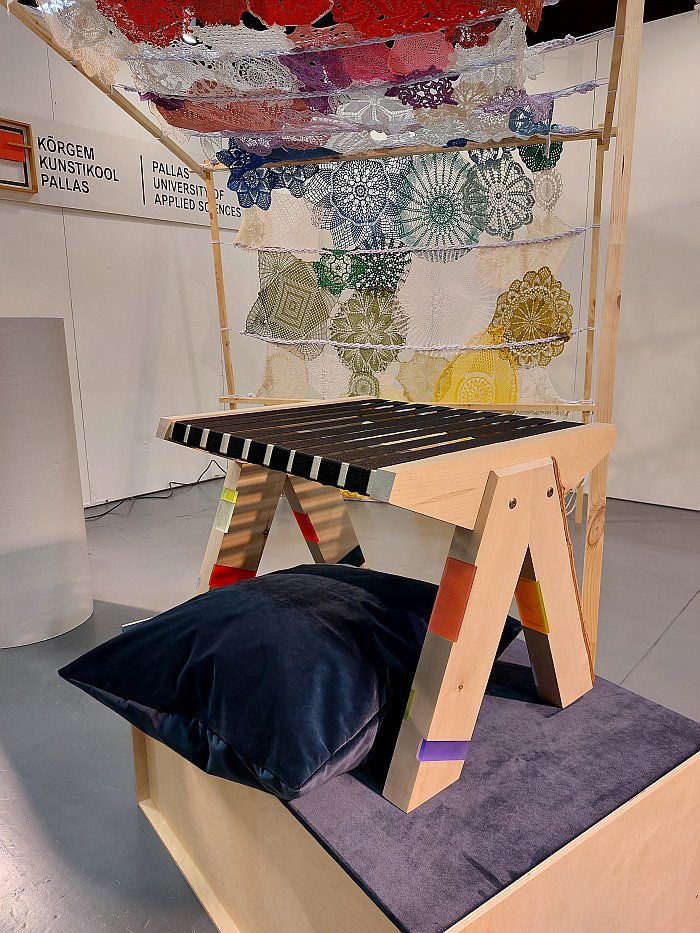
A 1959 stool that reappears in various contexts in the projects resulting from the Pallas students' rethinking of Bruno; a recurrence of the stool that could lead one to criticise a certain narrowness in the appreciation of Tomberg that was rethunk, rethought, and thereby a narrowness of the 2025 Tomberg that thus arose. A criticism that can be made, perhaps should be made, but which we'd counter with an argument that that 1959 stool embodies so much of Tomberg, is so informative and instructive on and off Tomberg, that is a very natural place to go to when starting your thinking about, rethinking of, Tomberg, is an excellent point of departure.
And on the other, the variety of ways in which the stool was rethought tends to make the stool almost irrelevant. It's the rethinking you engage with.
Be that in Kiil by Minna Arukaevu, Miina Aleksandra Piho and Liisi Tasso, a work whose name, Kiil = Wedge, allows for amusing reflections on Quentin Tarntino's unmade Estonian action movie Kiil Bill, and which employs half of Tomberg's stool, a kiil of Tomberg's stool, as the basis for a multi-function wall shelf where Tomberg's yarn has been replaced for the toppermost shelf by a woollen cord realised, as one is informed, via the so-called MultiWeave method developed at Pallas by Kadi Pajupiss and Liisi Tamm, and which combines weaving with 3D printing technology to enable the creation of 2D and 3D objects, a MultiWeave that is a reminder that applied art and design schools carry out technical research as well as artistic and speculative research, something that, arguably, a Bruno Tomberg advanced and promoted in context of the developing technical and material realities of the Estonia of the 1960s, 70s and 80s; or Bäriet by Sigre Kodasma, Grete Ottis and Markus Margus that rethinks the craft informed industrial construction of Tomberg's stool's end section in single pieces of plywood, i.e. completes an industrialisation Tomberg was moving towards, and arguably, would have argued was worth considering, a rethinking that plays with the relationships between length and depth of Tomberg's stool, and also leaves an ambiguity as to whether it is a stool or a side table, and thereby reminds of the discussion from Mehr als echt (More than real) by Jun Yang at Stiftung Bauhaus Dessau of the moment when Marcel Breuer's B 9 switched from being a stool to a side table, was rethought from a stool to a side table, and the question why that happened, if it's OK it happened. Questions that are also part of the urgent Rethinking Bauhaus that very much must be undertaken today and to which Mehr als echt (More than real) ably contributes. In addition as a multi function object, one whose function is defined by the user, Bäriet opens a very nice dialogue with Tomberg's 1969 Rumm ja Vorm X stool, a work that for us must stand in the centre of approaches to the question of What is Bruno Tomberg? And while, yes we could loudly bemoan that none of the Pallas students took on a rethinking of the 1969 X stool, what you gonna do with it? Tomberg left all possibilities in your hands. It's all there. Arguably also with Bäriet, if, for us, less elegantly so.
And a Bäriet that also served as the basis for the Nostalgia shelving unit also by Sigre, Grete and Markus, an object whose side walls and inner shelves are the remanents of the plywood boards from which the profiles for Bäriet have been cut, an alternative take on the use of offcuts as practised by Marc Hoogendijk, Sara Szyber and Karl Ekdahl and as seen in The Value of Wood; and a decision that is not only most welcome from an environmental sustainability and responsibility perspective, but also as it enables a shelving unit that is open, visually light, and thus ideal for compact spaces, but whose graphic quality has an unforced, natural, ease, isn’t shouty or insistent. Another aspect that, arguably, underscores Bruno Tomberg's oeuvre, or his oeuvre if one considers his inlayed cabinets separately.
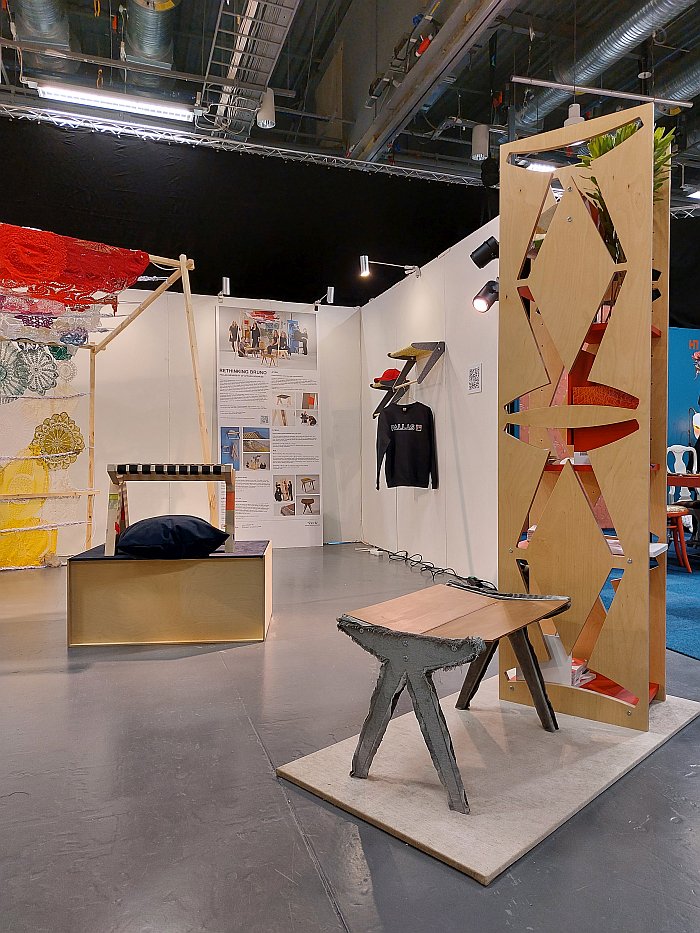
Among the recurring aspects of any and every design school semester project is a certain ease on the part of the students towards the constraints of the brief, the indifference with which they approach the details of the brief. That way they often ignore the brief and do their own thing. As we hope all design students will continue to do throughout their careers.
Something that on first glance is very much the case with Linila by Minna Arukaevu, Miina Aleksandra Piho and Liisi Tasso, a shelter, a room-in-room, crafted from spruce, cotton and woollen doilies that is based on a concept by Väino Tamm from the 1960s; a Väino Tamm who, as head of the Interior Design department at the Estonian National Art Institute from 1968 to 1986, was a long-time colleague of Tomberg. But wasn't Bruno Tomberg. A project, a shelter, that while, unless we missed it wasn't represented by an example of Tamm's original plan - which reminds us that neither was Bruno Tomberg's 1959 stool present in its original form, which may have been an interesting addition to the presentation, sadly far too few individuals are aware of the work of Tomberg - and thus without Tamm's proposition it is difficult to comment on the Rethinking Väino Linila represents. Alone one can say that in the use of doilies, of a recycling, upcycling, of expressions of a craft that, for good or bad, are no longer in demand today in context of their intended function, in conjunction with a simple wooden frame, Linila possess a resource footprint as small as its physical, and thus is very much indicative of what designers today should be striving for. While its use of the MultiWeave method allows for discussions on the role of contemporary technology in traditional craft as we, hopefully, approach the middle of the 21st century; allows for discussions on the role of contemporary technology in traditional craft a century after a Bruno Tomberg undertook such considerations.
And can also say that as a project Linila does allow the demanded rethinking of Bruno. A project that as a shelter, as space, a use of space, a defining of space, reminds that for all his stool designs Bruno Tomberg was, arguably, more a spatial, interior, designer than a furniture designer, that many of his furniture designs arose in context of his interior designs, and that any rethinking of Bruno needs must involve his spaces. A project whose existence more as a textile design project than a furniture or interior design project reminds that, as noted from Tallinn, a Bruno Tomberg is also a Moll Tomberg, the two essentially existing in a state of mutual cooperation and exchange, and that any rethinking of Bruno needs must involve rethinking Moll and rethinking the interplay between Bruno and Moll. Much as we need a Rethinking (of the relevance of the) Y chromosome in the narrative of design (hi)story.
And a project, a proposal by Väino Tamm, that was published in the Estonian furniture and interiors magazine Kunst ja kodu, a publication for whom Tomberg regularly wrote and to whose editorial board he long belonged, thus making Kunst ja kodu an important component of both Tomberg's journalistic career and his contribution to the development of design in Estonia through his role as an educator, as an educator of the wider Estonian public not just in a formal institutional context; a contribution that saw him not only mediate discussions on design and design's relationship with users, societies and environments, but through being such saw him help develop and expand definitions of design. A role as a public and institutional educator that allowed Bruno, along with his own works and in cooperation with Moll, to contribute to a rethinking of design in 20th century Estonia.
A Rethinking Design which is arguably the primary rethinking we needs all must undertake today. In Estonia, in Sweden, and beyond. A Rethinking Design in which a Bruno Tomberg can very much assist.
But for which he must be present in international discourses. A presence he currently doesn't enjoy. Not least, we'd argue, because when Thinking European Design only very few think east of the former Iron Curtain. Thinking European Design is very much a western European centred exercise. Which is as wrong as the focus on male designers. And a further aspect our Rethinking Design urgently needs to challenge.
And which means that for all the Pallas students were Rethinking Bruno, they were also enabling a thinking of Bruno, a thinking about Bruno; that for all the five projects presented in the Stockholm Furniture Fair's Greenhouse embodied aspects of a Rethinking Bruno their most important function was their contribution to approaching the important question, What is Bruno Tomberg? And why Bruno Tomberg?
More information on Pallas University of Applied Sciences can be found at https://pallasart.ee
And for all keen to discover more about Bruno Tomberg, the exhibition Bruno Tomberg. Inventing Design is scheduled to run at the Estonian Museum of Applied Art and Design, Lai 17, 10133 Tallinn until Sunday 30th March. Full details can be found at www.etdm.ee. And our thoughts from and views of the exhibition can be found elsewhere in these dispatches.
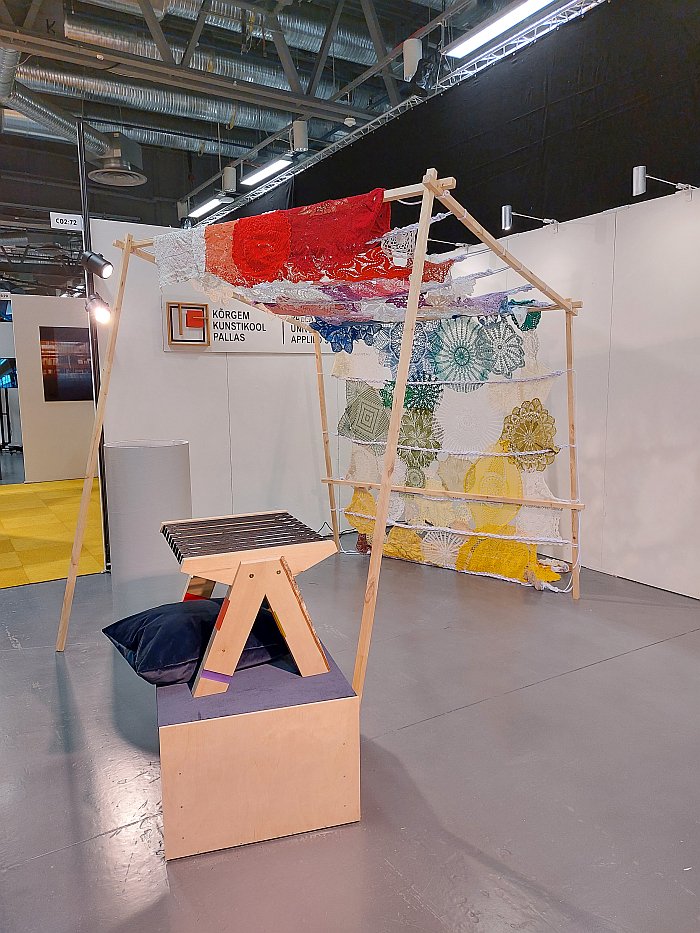
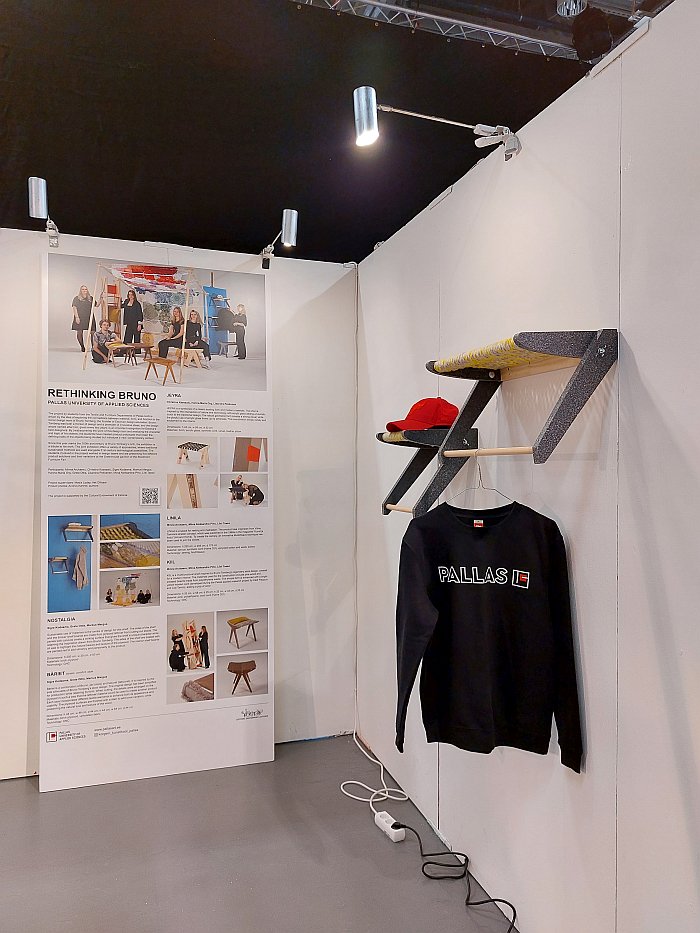
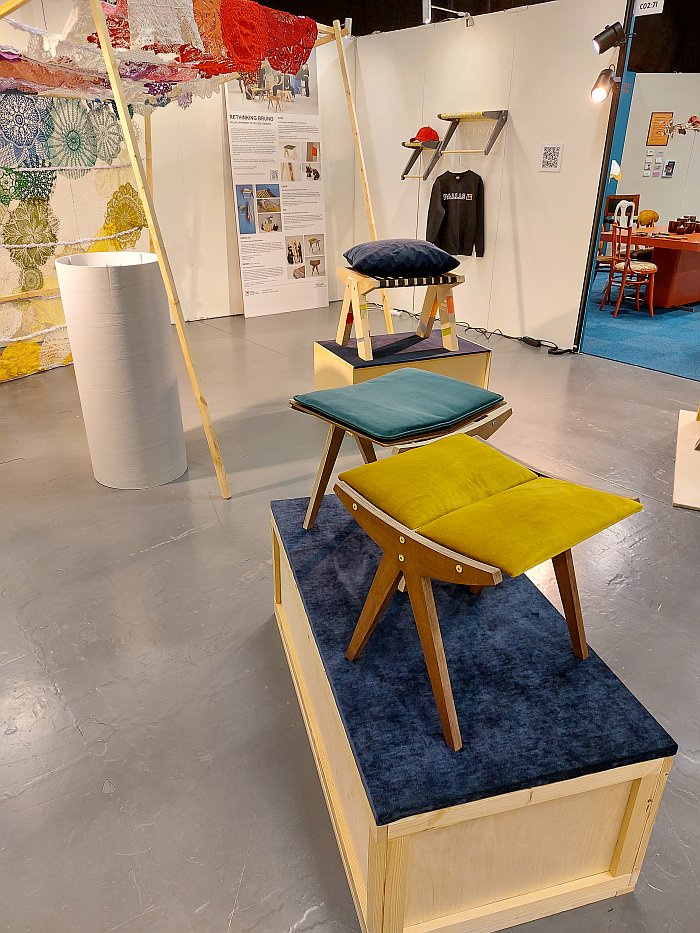
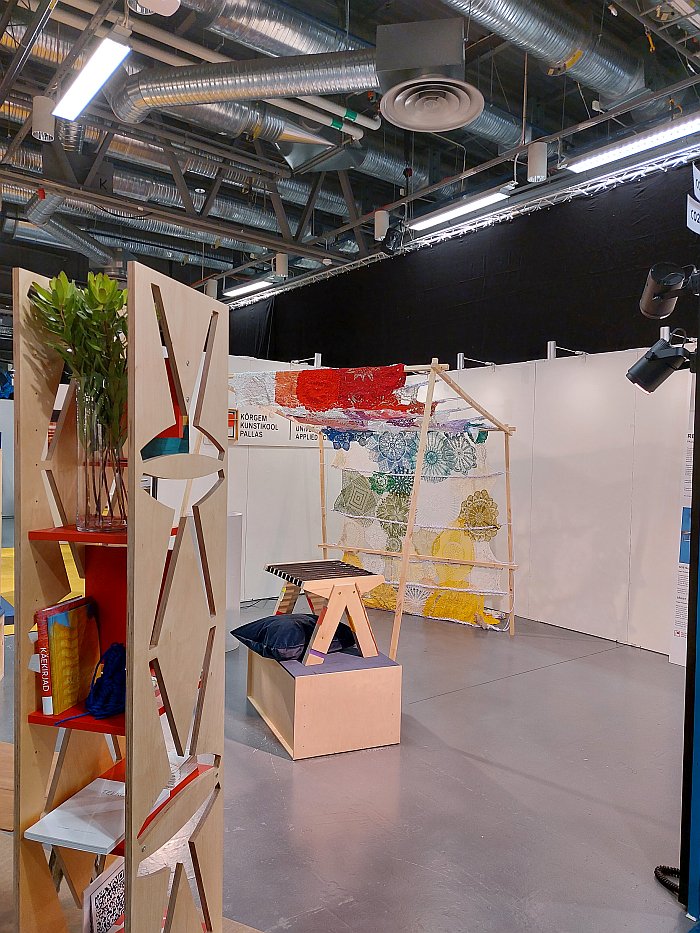
1Bruno Tomberg, Mis on disain? Pioneer Nr 11, November 1973, Tallinn, pages 36-37 In context of Bruno Tomberg. Inventing Design at the Estonian Museum of Applied Art and Design, Tallinn we briefly discussed the articles existence in the magazine of the Estonian Pioneer youth movement. See FN 2